The Comprehensive Guide to the Best Cattle Blowers
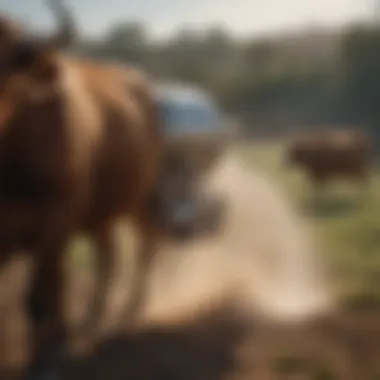
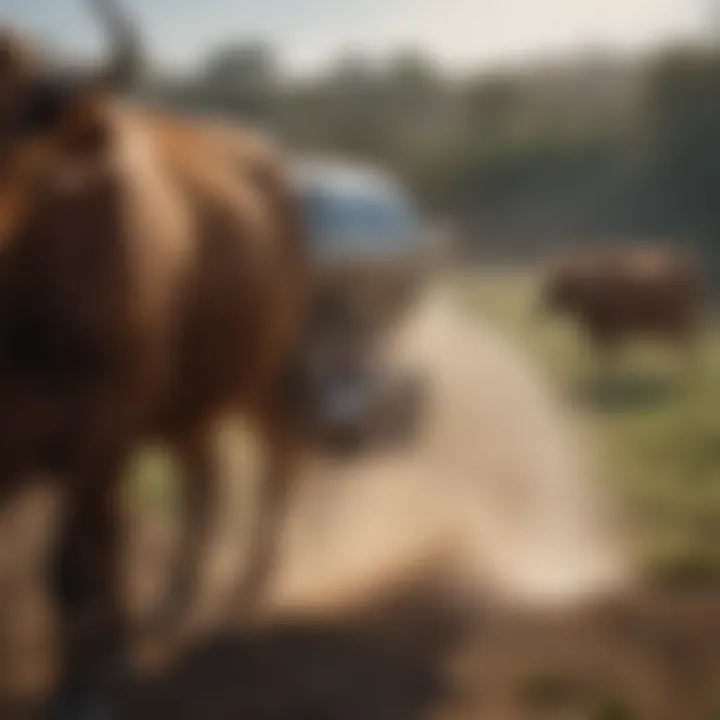
Overview of the Topic
Definition and Importance
Cattle blowers are specialized pieces of equipment designed for the grooming and care of livestock, primarily cattle. These machines play a critical role in removing dirt, loose hair, and parasites from the animals' coats, contributing to their overall hygiene and appearance. In agricultural settings, maintaining the health and comfort of livestock is paramount. A clean animal is less susceptible to diseases and discomfort, which makes cattle blowers essential. Moreover, sanitary practices in livestock management can lead to better product quality, whether it is milk, meat, or wool.
As farmers face an increasing demand for high-quality produce, the relevance of effective equipment like cattle blowers cannot be overlooked. Their benefits extend beyond hygiene; they also enhance the productivity of livestock by reducing stress and preventing health issues.
Current Trends
In recent years, there has been a noticeable shift towards more advanced and efficient cattle blowers. Manufacturers are integrating technology to make these machines more user-friendly and effective. Features such as adjustable speed settings, ergonomic designs, and energy-saving modes are becoming standard. Additionally, the market is seeing a rise in portable models, which cater to both large-scale and smaller farms, providing flexibility in livestock management.
The trend towards eco-friendly practices also influences the design of cattle blowers. Devices that minimize noise and reduce energy consumption are gaining popularity among environmentally conscious farmers.
Key Techniques and Practices
Step-by-Step Guide
- Preparation: Before using a cattle blower, ensure that the area is clean and free of obstacles. Herd the cattle into a secure and accessible space.
- Introduction: Gradually introduce the cattle to the blower, allowing them to sniff and inspect the equipment before use. This step reduces anxiety and encourages cooperation.
- Operational Settings: Adjust the blower's settings to a lower speed for initial use. This helps acclimate the animals to the noise and airflow.
- Grooming Process: Start from the neck and move towards the tail, blowing loose hair and dirt away. Avoid blowing directly into the animal's face; rather, direct the airflow towards the body.
- Post-Grooming Check: Once grooming is complete, check the animal for any signs of skin irritation or discomfort.
Tools and Equipment Needed
- Cattle Blower: The primary tool required.
- Extension Cord: For electric blowers, ensure you have a long enough extension wire to reach your working area.
- Cleaning Supplies: Brushes and grooming tools for enhancing the effectiveness of the blowing process.
Challenges and Solutions
Common Obstacles
Farmers may encounter several challenges when using cattle blowers. One major issue is the reluctance of animals to accept the blower due to noise or unfamiliarity. Additionally, improper use can lead to skin irritation or fatigue in the animal if done for too long.
Innovative Solutions
To address the reluctance of livestock, it is essential to familiarize the animals with the equipment. Conducting training sessions can significantly ease the anxiety associated with the noise. Introducing the blower gradually, as mentioned in the step-by-step guide, is also effective. Moreover, farmers can monitor the time spent on each animal, ensuring not to exhaust them and keeping their comfort a priority.
"Proper use of cattle blowers not only enhances animal welfare but also increases overall farm productivity."
By employing these techniques and understanding the common challenges, farmers can transform the task of grooming into a more efficient and less stressful process.
Understanding Cattle Blowers
Cattle blowers play a vital role in enhancing the overall management of livestock by promoting cleanliness and comfort. Understanding their significance is crucial for those engaged in agriculture and farming. These devices, primarily designed to remove excess moisture, dirt, and debris from cattle, help to improve the hygiene standards within farms. An effective grooming routine is not only essential for showing animals but also contributes to their health and well-being. Hence, a proper grasp of how cattle blowers function can drive better practices in livestock management.
Definition and Purpose
Cattle blowers are specialized grooming devices that utilize forced air to efficiently dry and clean the coats of livestock. They function by blowing air over the animal's body to eliminate moisture, dust, and loose hair. This process not only ensures that the cattle appear clean for shows or sales but also helps in the prevention of skin issues caused by dampness and debris. The primary purpose of these blowers is to maintain the hygiene of the animals, which is essential for their comfort and health. Additionally, the use of cattle blowers can significantly speed up grooming routines, allowing farmers to manage their time and resources more effectively.
History and Evolution
The development of cattle blowers traces back to the advancement of agricultural equipment designed to facilitate livestock care. Initially, farmers relied on manual methods for grooming, which were labor-intensive and time-consuming. As automation and technology improved, the cattle blower emerged as an essential tool. The first models were often bulkier and less powerful, making them less effective. Over time, manufacturers began to innovate, creating electric blowers that provided consistent air pressure and made the process simpler. Modern cattle blowers vary widely in design and features, with advancements aimed at improving portability, efficiency, and functionality. Today, these devices are crucial in both commercial farms and small-scale operations, reflecting the growing awareness of animal welfare standards in the agricultural sector.
Benefits of Using Cattle Blowers
Cattle blowers are essential tools for efficient livestock management. Their role extends beyond simple grooming; they contribute significantly to the overall health, hygiene, and comfort of the animals. Understanding these benefits helps farmers and agricultural professionals decide on investment and usage strategies. This section will elaborate on the importance of cattle blowers, including very specific benefits.
Enhanced Animal Hygiene
One of the primary benefits of using cattle blowers is the marked improvement in animal hygiene. Cattle are prone to dirt, dust, and parasites that can compromise their skin and coat health. Regular use of a cattle blower helps remove loose hair, dirt, and debris, ensuring animals are clean and comfortable.
Moreover, a cleaner coat reduces the likelihood of skin infections, which can plague livestock if not addressed timely. Maintaining hygiene is particularly critical in environments where cattle are kept close together, as it minimizes the spread of diseases. In addition, clean cattle are less likely to attract flies and other pests, which can lead to additional health complications.
Using a blower, farmers can achieve a more thorough cleaning compared to traditional brushing. This efficiency in hygiene translates into better overall management of the herd. By investing in a reliable cattle blower, farmers protect not just the individual animal's health, but also the health of the entire herd.
Improved Health and Comfort


The health and comfort of livestock are paramount in any farming operation. Cattle that are well-groomed experience less stress and discomfort. Proper grooming using a cattle blower can stimulate circulation and promote the natural oils in the skin. These factors collectively enhance the overall well-being of the animals.
Furthermore, well-maintained cattle are better able to regulate their body temperature. In colder months, the reduced coat thickness from frequent blow-drying prevents overheating. Conversely, in warmer months, a cleaner, less dense coat may help keep the animal cooler.
This positive impact on comfort correlates directly with livestock productivity, leading to better yields and improved quality of product. Stress in animals can lead to decreased milk production and lower weight gains. Cattle blowers help mitigate such issues by providing a level of comfort that supports animal performance.
Efficiency in Grooming
Cattle blowers are designed to streamline the grooming process, making it faster and more efficient. Traditional grooming methods often involve significant manual labor and time, particularly with larger herds. By contrast, using a cattle blower drastically reduces grooming time, allowing farmers to focus on other essential tasks.
These blowers operate quickly and effectively, ensuring that operators can groom multiple animals in a fraction of the time it would take with conventional techniques. This efficiency is critical for large-scale operations, where every minute counts.
Additionally, the effectiveness of blowers means that the quality of grooming is optimized. With powerful airflow, blowers effectively lift away dirt and debris while also fluffing the coat, resulting in a neat appearance. Investing in quality grooming equipment provides long-term benefits, not just in terms of time saved, but also in maintaining a higher overall standard of care.
Key Features to Consider
When selecting a cattle blower, understanding the key features is vital. These features significantly impact the effectiveness, user-friendliness, and longevity of the equipment. By focusing on specific elements such as power, portability, and durability, farmers can make informed choices that ultimately enhance their livestock management processes. This section will explore these critical areas in depth.
Blower Power and Performance Levels
The power of a cattle blower is essential for ensuring optimal performance. Power ratings directly influence the airflow and drying capabilities. A higher power blower will often have stronger airflow, which allows for quicker drying times.
Here are some important points regarding blower power:
- Horsepower Ratings: Check the horsepower specifications. Most effective blowers range from two to five horsepower, depending on the scale of use.
- Airflow Volume: Measure in cubic feet per minute (CFM), this indicates how much air the blower can move, which greatly affects its efficiency.
- Adjustable Settings: Many modern blowers allow users to adjust the power settings. This adds versatility, enabling operators to select the appropriate power for different conditions.
Portability and Ease of Use
Portability can be a deciding factor for many farmers. Movable equipment can lead to higher efficiency and ease in management. When considering portability, evaluate the following:
- Weight and Size: For ease of movement, lighter models are preferable. This allows for maneuverability, especially in larger farm settings.
- Handle Design: Ergonomic handles make the blower easier to use for extended periods.
- Cordless Options: Battery-powered blowers enhance portability. They can be used in areas without electrical access. They provide mobility while maintaining sufficient power.
Durability and Maintenance Requirements
Durability is a critical element that cannot be overlooked. Investing in a durable cattle blower means less frequent replacements and reduced long-term costs. Consider these factors:
- Material Quality: Check the materials used in construction. High-quality plastic and metal components resist wear and tear better than inferior alternatives.
- Maintenance Needs: Some blowers require more upkeep than others. Models that have easily replaceable filters and parts improve the user experience by simplifying maintenance tasks.
"A well-maintained cattle blower can significantly extend its lifespan and performance."
- Warranty and Support: Consider the warranty offered by the manufacturer. A good warranty often reflects confidence in the product's durability.
Types of Cattle Blowers
Understanding the different types of cattle blowers is crucial for effective livestock management. Each type offers distinct advantages that can significantly impact the grooming process and, ultimately, the health and comfort of cattle. The choice of blower can affect the grooming efficiency and the overall results you achieve in maintaining animal hygiene. Knowing the options available can help farmers and livestock handlers make informed decisions tailored to their specific needs.
Electric Cattle Blowers
Electric cattle blowers are among the most widely used types in the market. These machines typically plug into a standard outlet, providing a consistent source of power. The primary benefit of electric models is their high efficiency and power output. They are capable of producing strong airflows, which help remove dirt, debris, and moisture from the animal's coat effectively.
Additionally, their performance remains steady and reliable during extended use. Electric cattle blowers tend to have durability features, which is beneficial in demanding farm environments. However, they do come with some considerations. Electric models require access to power outlets, limiting mobility to areas where electricity is available.
Battery-Powered Models
Battery-powered cattle blowers offer remarkable versatility. These blowers run on rechargeable batteries, allowing for greater mobility on farms without the constraints of cords or outlets. This can be especially advantageous in large pastures or when working on the go. The designs of these models are often more compact and lightweight, making them easy to handle.
Despite their convenience, they may lack the raw power that electric blowers provide. Battery life can also be a factor, usually depending on the blower's power settings and usage duration. Farmers may want to consider the capacity of the battery and the expected duration of use before opting for this type. Maintaining these models involves regular battery checks and potential replacements over time.
Inflatable Cattle Blowers
Inflatable cattle blowers represent a more innovative approach to cattle grooming. These blowers utilize airflow to inflate a structure that often surrounds the animal. Designed for controlled cooling and drying, they are particularly valuable in specific settings, such as shows or exhibitions. Inflatable models can help reduce stress on animals during grooming, providing a gentler method compared to traditional blowers.
While they are unique tools, their use may be somewhat niche. Farmers should evaluate whether an inflatable blower suits their primary grooming needs, as they may not replace electric or battery-powered models in standard grooming tasks. Ensuring proper setup and safety is also essential when using inflatable blowers since they can be larger and may require additional space.
Choosing the right type of cattle blower will depend on various factors, including the scale of the operation, the grooming needs of the cattle, and their environment. Ultimately, understanding these options aids in promoting better hygiene practices and enhancing the welfare of the animals.

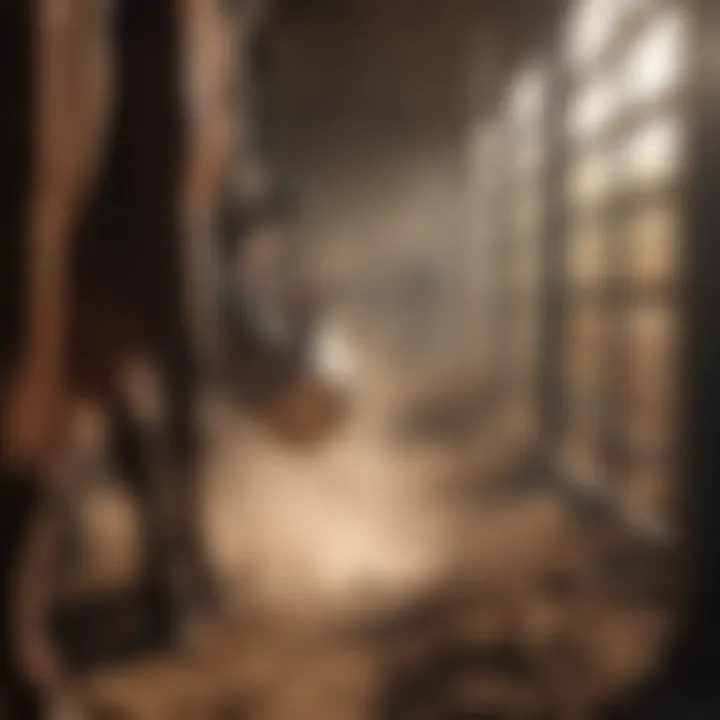
Top Cattle Blowers in the Market
Choosing the right cattle blower is essential for optimal livestock management. The market offers a variety of models, each with unique features and specifications that cater to different needs. Farmers and agricultural professionals must assess these options carefully to ensure they invest in a product that enhances animal care efficiency, hygiene, and overall health.
Understanding what makes a cattle blower stand out can make all the difference. Key elements include power levels, portability, and maintenance requirements. A well-chosen blower can significantly reduce time spent on grooming while providing superior results.
Comparative Analysis of Popular Models
Several popular cattle blower models have garnered attention among agricultural professionals. Each model comes with distinct pros and cons that can influence purchase decisions.
- X Brand Super Blower
- Y Brand GroomMaster
- Z Brand ActionSpray
- Power: This model is known for its high-speed motor that effectively removes dirt and debris.
- Portability: With a lightweight design, it can be easily maneuvered around the farm.
- Durability: Built with high-quality materials, it withstands harsh environmental conditions.
- Power: Medium power suited for regular grooming of cattle.
- Ease of Use: Features intuitive controls that make it user-friendly.
- Maintenance: Requires less frequent maintenance, ideal for busy farmers.
- Power: Offers adjustable settings for various grooming needs.
- Storage: Compact design allows easy storage when not in use.
- Warranty: Comes with a generous warranty period, providing peace of mind.
This analysis emphasizes the importance of evaluating each model based on personal or farm-specific requirements. The right choice can lead to improved satisfaction for both the cattle and the service personnel.
Pros and Cons of Leading Brands
Each of the market's leading brands has strengths and weaknesses, and understanding them is vital for informed decision-making.
X Brand:
- Pros: High performance and durability.
- Cons: Higher price range may not fit every budget.
Y Brand:
- Pros: Good balance of performance and affordability.
- Cons: May lack advanced features found in higher-end models.
Z Brand:
- Pros: Versatile options for different grooming needs.
- Cons: Slightly heavier, which may affect portability.
Important: It is essential to assess the specific needs of your livestock when choosing a brand, as the optimal selection can lead to enhanced productivity and health for your animals.
These considerations play an essential role in guiding purchasing decisions. Selecting the right cattle blower is not merely about finding a tool, but about investing in better care for the animals that contribute so much to the farmer's livelihood.
Best Practices for Using Cattle Blowers
Using cattle blowers effectively can enhance animal grooming and hygiene. Proper practices can also prevent unnecessary stress for cattle, ensuring their comfort throughout the grooming process. Understanding how to prepare, execute, and care for livestock post-grooming leads to better results and overall animal well-being.
Preparation and Setup
Before using a cattle blower, preparation is key. Ensuring the area is clean and safe helps make the experience smooth for both the operator and the animal involved. First, check the power source; if it’s electric, ensure that the extension cords are in good condition and rated for the blower’s power needs. If using a battery-operated model, verify that the battery is fully charged.
Next, select an appropriate spot for the grooming process. A quiet, familiar environment reduces stress for the animal. Gather all necessary tools nearby, which may include brushes and a comb, so they are easily accessible. Finally, inspect the cattle blower itself. Look for any damage or debris that could interfere with its operation.
Techniques for Effective Grooming
The process of grooming with a cattle blower should be both efficient and sensitive to the animal's needs. Start the grooming process by introducing the blower to the cattle in a calm manner. Let the animal see the equipment while it is turned off to familiarize it with the machine. This can help to lower anxiety levels.
When operating the blower, maintain a slight distance from the animal's body. This not only avoids overwhelming the cow with strong airflow but also allows for better control of the air direction. Move the blower in consistent, sweeping motions, directing the air away from the animal's face and sensitive areas.
Using a cattle blower can enhance grooming efficiency by helping to remove dirt, debris, and loose hair, contributing to better overall animal health.
Post-Grooming Care
After grooming, post-care for the animal is equally important. Ensure that the cattle is calm and comfortable after the grooming process. Check the animal for any signs of discomfort; if any issues arise, it might require immediate attention.
Additionally, clean the cattle blower according to the manufacturer's guidelines, removing any hair or particulates that could impede its function during future use. Store the equipment in a dry place to prevent damage. This ensures its longevity and effectiveness for future grooming sessions. Regular attention to maintenance will promote better performance and extend the useful life of your equipment.
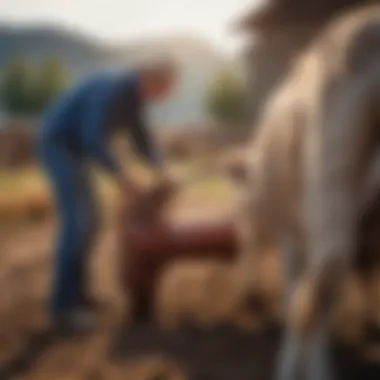
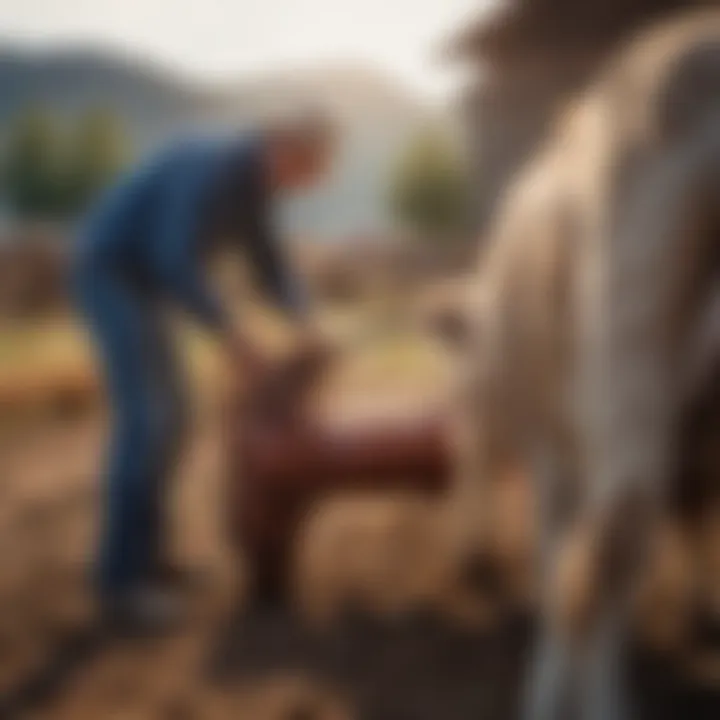
Implementing these best practices leads to more successful grooming sessions and contributes to better animal care overall.
Maintenance and Care of Cattle Blowers
Maintenance and care of cattle blowers is crucial for ensuring their longevity and effective performance. Proper upkeep guarantees that these machines continue to operate efficiently, providing essential grooming for livestock. Neglecting maintenance could lead to reduced blower performance, increased repair costs, or even the need for a complete replacement.
Regularly caring for your cattle blower not only prolongs its life but also ensures optimal performance during grooming tasks. Consistent maintenance can prevent a minor issue from escalating into a significant problem, which could disrupt operations on the farm. Furthermore, maintaining your equipment helps avoid potential injuries, such as electrical malfunctions or moving parts mishaps.
Routine Maintenance Tasks
Implementing a routine maintenance schedule is essential for maximizing the efficiency of your cattle blower. Here are some tasks to include:
- Cleaning Filters: Regularly clean or replace air filters to prevent dirt buildup that can hinder airflow and performance.
- Inspecting Hoses: Check hoses for cracks or leaks. Replace damaged sections to maintain proper air pressure.
- Lubricating Moving Parts: Apply lubricant to moving components as needed to minimize friction and wear.
- Checking Electrical Connections: Ensure all electrical components are connected securely. Look for signs of wear or damage.
- Storing Properly: After use, store the blower in a dry and safe place to protect it from weather conditions that could cause corrosion or damage.
This ongoing commitment to maintenance will ensure that your cattle blower remains reliable and functional over the long term. Regular checks also provide the opportunity to identify potential issues before they become serious problems.
Troubleshooting Common Issues
Despite proper care, there may still be instances when issues arise with your cattle blower. Understanding common problems and potential solutions can restore its functionality quickly. Here are a few common issues:
- Overheating: If the blower overheats during use, it could be due to a blocked air filter. Allow it to cool down and clean the filter.
- Reduced Airflow: If airflow appears weak, check for obstructions in the hose or blocked air filters.
- Unusual Noises: Strange sounds may indicate that moving parts need lubrication or that a component is malfunctioning.
- Electrical Problems: If the motor does not start, inspect the power source, check the electrical connections, and ensure the outlet is functioning.
Keeping a troubleshooting guide handy can streamline your response to equipment issues, minimizing downtime during critical grooming windows.
Efficient maintenance and establishment of troubleshooting protocols create a more productive environment. This conscientious approach reflects an overall attitude towards the operational capabilities of your cattle blowers, leading to better management of livestock care.
Future Trends in Cattle Grooming Equipment
As agriculture and livestock management move forward, it is essential to recognize how equipment used for grooming cattle will evolve. The trends in cattle grooming equipment not only reflect technological advancements but also address the increasing demands for efficiency and animal welfare. Understanding these trends is significant for farmers and agricultural professionals aiming to enhance their livestock care practices and overall farm productivity.
Technological Innovations
New technologies are shaping the landscape of cattle grooming. Innovations focus on making grooming more effective and convenient. For instance, the integration of smart technology in cattle blowers allows for programmable settings, enabling users to tailor performance based on specific needs. Such advancements contribute to time savings, as farmers can automate routine grooming tasks.
Furthermore, advancements in motor technology have led to the production of blowers that are both quieter and more powerful. This reduces stress on animals during grooming sessions while ensuring maximum efficiency in removing dirt and debris. Additionally, the introduction of energy-efficient models helps in reducing operational costs.
"The future of cattle grooming equipment lies in smart, efficient, and sustainable technology that benefits both animals and farmers."
Sustainability Considerations
Sustainability is becoming increasingly important in agriculture, including cattle grooming. Manufacturers are beginning to consider environmentally-friendly materials and practices in the production of grooming equipment. This change is significant as it addresses the growing concerns regarding the environmental impact of livestock farming. Tools that utilize less energy not only help in reducing carbon footprints but also promote cost savings for farmers in the long term.
Moreover, some cattle blowers now feature recyclable components and biodegradable packaging. Farmers can make better choices that support the planet. The shift towards sustainable practices in grooming equipment reflects a broader movement within the agricultural sector to promote ecological responsibility.
The End
In summing up the extensive examination of cattle blowers, it is crucial to underscore the multiple benefits that these tools provide in livestock management. Cattle blowers are not merely accessories; they play an essential role in ensuring the health and comfort of cattle. By effectively removing dirt and debris, they enhance animal hygiene significantly. Improved cleanliness prevents the development of skin issues and other health complications, which can affect livestock productivity.
Furthermore, the usage of these blowers promotes better grooming practices. Grooming is vital for the psychological well-being of cattle, contributing to their overall comfort. A cattle blower can reduce the amount of time spent on grooming, allowing farmers to focus on other critical tasks within their operations. Thus, the efficiency of cattle blowers translates directly to enhanced productivity on the farm.
When considering the future of cattle grooming practices, advancements in technology are set to enhance the functionality of these blowers. Innovations are expected to lead to more powerful and user-friendly models, making them accessible to a broader range of farmers.
Using cattle blowers can be a game-changer in livestock management, aligning with best practices for animal welfare.
This article has offered insights into the various types of cattle blowers, their key features, comparative analyses, and maintenance tips. Each of these elements is vital in helping farmers choose the right equipment for their needs. Therefore, dedicating time to understand these tools can lead to better livestock care and improved farm management overall.
Summary of Key Insights
The comprehensive analysis highlights several critical points:
- Importance of Hygiene: Cattle blowers increase hygiene standards, which is essential for health.
- Grooming Efficiency: They make grooming quicker and more efficient.
- Technological Growth: New advancements will improve blower performance.
- Maintenance: Regular upkeep ensures optimal functionality and longevity.
These insights underpin the necessity of implementing cattle blowers in modern agricultural practices. By embracing these tools, farmers can make measurable impacts on their livestock's health and operational efficiency.
Final Recommendations
For optimal use of cattle blowers, a few recommendations stand out:
- Assess Your Needs: Consider the specific needs of your cattle before selecting a blower.
- Evaluate Features: Focus on power, portability, and durability in your choice.
- Prioritize Maintenance: Follow recommended maintenance routines to prolong the life of your equipment.
- Stay Informed: Keep abreast of new models and technologies that come to the market.



